How do you buy a sauna that’s right for your home and family? This expert, unbiased guide will help you choose the right type of sauna, sauna heater, size, features, controls, and more.
In the chilling cold of Finland, the people discovered more than 2000 years ago that there was no better way to relax, soothe aching muscles, and cleanse the body than to luxuriate in a super-heated sauna hut.
Today, in cold and warm climates alike, people are discovering the benefits and pleasures of saunas—and the best saunas have become more affordable and easier to install than ever before.
Most Finnish sauna enthusiasts bathe in their birthday suits, seated on a folded towel. Some switch their bodies with birch branches to stimulate circulation and open pores; all shower after (and sometimes in between) sauna sessions. A complete sauna experience may involve an initial shower, two or three 5- to 10-minute sessions in the hot room, and then a shower afterward.
The word “sauna,” pronounced “sow (like cow) nah,” is Finnish for bath or bath house; it is both process and place. Today, the traditional sauna consists of a compact, softwood-lined room with wooden benches and a special stove or heater (“kiuas”).
Rocks arranged on and inside the heater are an essential part of the true Finnish sauna; they provide a very even, consistent heat that normally ranges from about 165 to 195 degrees F. Ladling water over these hot stones produces a humidifying vapor (“loyly”) that is the essence of a traditional sauna. Sometimes given a natural fragrance, this steam helps to open pores.
The bathing process is relaxing and refocuses and cleanses the body from the inside out by releasing impurities through perspiration. As the skin warms, blood vessels dilate, encouraging blood flow and opening sweat glands. Oils, dirt and impurities—including toxins such as nicotine, mercury, and lead—are drawn to the surface. A shower washes them away.
Of course, many people sauna (the word is also a verb) simply because it feels great. When heat surrounds our bodies, they release endorphins—a class of hormones that create a feeling of well being, giving us a natural high. Warmth also soothes muscles, relieving aches and pains. And people tend to sleep better after a sauna. A 10- to 20-minute sauna increases the heart rate, providing a similar metabolic result to mild exercise.
A Finnish sauna may offer both dry and moist heat. When using a heater without added moisture, the humidity is only about 12%, which is too dry for some people. If that’s the case, water can be poured on the heated stones to bring humidity up to about 24 to 28 percent. Even though this is still a relatively low humidity, one’s body senses the moisture more because of the heat. Doing this makes pores open quicker. And it helps a person to breathe easier.
Precut Sauna Kits
For a precut sauna kit, you may need construction help.
With these, you provide the wall studs, insulation, and exterior walls, and then must build the unit from precut pieces.
A precut kit typically includes wall and ceiling boards, assembled benches, a pre-hung door, floor decking, a sauna heater, and a variety of accessories, from back rests to heater fences, vents, and controls.
Major manufacturers may modify their precut kits to accommodate custom sizes. From your blueprint or floor plan, they will custom-size a sauna to fit any space—even if the design includes curves and angles, or just if you want dramatic windows.
But unless you’re working with an odd space, you probably don’t need to buy a custom-made sauna because manufacturers offer so many sizes and configurations of both precut and prefabricated standard sauna kits at lower prices.
Modular Prebuilt Saunas
Modular or prefabricated saunas cost a bit more than precut kits but are much easier to erect.
Because of the labor savings, total costs are similar to precut saunas—and you can have one installed (or do it yourself) in half a day.
If you move or want to relocate the sauna, you can take it apart and reassemble it somewhere else. They have two-sided, pre-insulated walls and ceilings that simply lock together.
Benches, back rests, and floor decking all come pre-assembled.
For example, Harvia makes a prebuilt sauna that has 1-by-4 clear cedar or vertical-grain redwood on the interior and rough-sawn fir on the exterior.
Between the two surfaces are 2-by-2 wall studs and R11 foil-backed fiberglass insulation. Other options are also available—for instance, you can get rough-sawn Douglas fir plywood exterior or an imported sauna that is built from Nordic spruce logs.
The concept of prefabricated modular saunas is the fastest growing part of the sauna business. Precuts represented about 90% of sales until recent years. Now, choice is gravitating more to prefabricated saunas.
Although prefabs once were just square boxes, now designs of prefabs are handsome and contemporary with deluxe interiors, low-voltage lighting, interesting angles, and plenty of glass.
Finlandia offers a complete, insulated outdoor sauna, complete with roof package; available in 4-by-4-foot to 8-by-8-foot sizes designed for assembly on an existing slab.
Taking the prefabricated concept to its ultimate conclusion, the Helo Porta-Saun and the Finnleo Thera-Port come complete in just two pieces that you can lock together in a couple of minutes. These are popular “portables” for people who live in apartments or condos.
Types of Wood for Saunas
The best sauna interiors are made of handsome softwoods that remain relatively cool and absorb steam, making the room more comfortable.
Cedar is a very popular wood in North America. It is handsome, has natural resistance to decay, weathers extremely well in a sauna’s harsh environment, and is aromatic.
Saunas built of Nordic white spruce are more traditionally Finnish. This material is a beautiful, white-toned, fine-grained wood with very tight ‘living’ knots that are about the size of a pencil eraser. From very slow-growing woods in Finland’s sustainable forests, it darkens only slightly with age. Prices are comparable with cedar.
An excellent wood for benches and backrests is Abachi, another light-toned softwood that looks great with Nordic white spruce.
Other woods used for saunas include clear aspen, clear vertical-grain hemlock, and clear all-heart redwood, although manufacturers seldom use redwood because of its high cost and the fact that it darkens almost immediately.
Domestic spruce and pine have a white wood look when new, but are not the same quality as imported Nordic white spruce. These woods tend to have larger, looser knots that will eventually fall out as the wood dries.
The Right Size for a Sauna
What dimensions should a new sauna ideally have? To minimize heat loss, standard ceiling height is 7 feet. Typical room sizes are from 4 by 4 feet to 8 by 12 feet.
When planning a sauna’s size, figure you’ll need at least 2 feet of bench space for each bather; ideally, bathers should be able to recline, so, if possible, allow 6 feet in one direction.
Be aware that the size dictates not only how many people can comfortably sauna at a given time but also the output capacity of the heater you’ll need.
Most saunas have benches at two heights, an upper bench, about 36 inches high, and a lower bench, about 18 inches high. Upper-bench widths are typically 18 to 24 inches.
The lower bench has three functions: it serves as a step, provides a footrest when you sit on the upper bench, and offers a significantly lower temperature zone for when the upper-bench area feels too hot.
Some manufacturers make a sliding lower bench that eases cleaning. Most saunas have removable duckboard flooring; some offer flooring made of flexible, web-like polymer sections that simply snap together.
Some saunas have windows; many have a glazed door that provides an open feeling. Glass options include clear, opaque or even etched with a design. But remember: the more windows, the greater the heat loss. Choose energy-saving glazing that has a 1/2- to 1-inch air space between the two outer layers of tempered safety glass.
Sauna Heaters & Controls
The heart of a sauna is its heater. Wood-burning sauna stoves are a traditionalist’s dream, providing the soft heat and crackle of a fire.
But unless you live where electricity is not available, love tending a fire, and don’t mind the lack of heat control, you’re probably better opting for an electric sauna heater.
Also be aware that wood stoves are not permitted by some codes and demand a larger room because of required clearances from wood walls.
Small electric sauna heaters may be wall-mounted; large ones are freestanding. Be sure you select a size that can handle the sauna’s space; these specifications come with the heater.
Choose a heater that is made by a well-known manufacturer, is UL approved, and backed by a strong warranty. Look for stainless-steel elements, triple-wall construction to minimize the unit’s surface temperature (for safety), and a design that puts plenty of rocks in direct contact with heating elements.
Some heaters have built-in controls, others connect to wall-mounted controls; decide which will be most convenient for you.
Though controls range from simple mechanical dials to sophisticated, programmable electronic touch switches, all should have a silent 60-minute timer that shuts the heater off in case you fall asleep (which is not a safe sauna practice).
It’s also smart to choose a timer that allows you to preset the heater several hours before you’ll need it. That way, your sauna can be waiting for you with a warm welcome when you return from a hard day.
Costs of Buying & Operating a Sauna
Prices for saunas start at about $1,000 for a two-person, 4-by-4-foot precut model.
Prefabricated models start at about $3,000 and may sell for $12,000 or more.
The ultimate price of a sauna depends on the unit’s size, the species and quality of woods, quality of equipment, and options—which are many.
Finnleo, for example, offers spruce doors with traditional windows, window grids, an all-glass door, a Douglas fir door, and etched glass. Finlandia offers an optional cedar exterior and negative etched-glass door for privacy.
When determining how much to spend, remember that a sauna pays off not only through enjoyment, but by increasing property values and maybe even decreased healthcare costs.
How much does a sauna cost to operate? That depends on your local cost per kilowatt hour (noted on your electric bill), the kilowatt rating of your heater, and how much you use your sauna.
Multiply your costs per kilowatt hour, say 10 cents, by the heater’s rating, say 6 kilowatts. In this example, the sauna would cost 60 cents per hour to operate. An idle sauna doesn’t cost anything.
Far-Infrared Saunas
A far-infrared sauna uses far-infrared radiation to heat your body. This type of radiant heater warms your body the way the sun does rather than heating the air in an enclosed space.
Far-infrared heat encourages healthy joints, muscles, tissues, and blood flow, and helps cleanse the body of harmful toxins such as heavy metals and cholesterol. It may be helpful for lowering blood pressure, relieving arthritis, and aiding in other conditions. And it most certainly is relaxing.
Because they heat your body, not the air, far-infrared heaters work in any room and, in fact, portable models can be used anywhere. Many types, however, are installed in wooden rooms similar to those used for traditional saunas. Rooms may be sized for one, two, three, or more people. The heater or, in some cases, the entire sauna can often be plugged into a conventional 120-volt electrical outlet.
Most manufacturers are located in the United States and Canada. If you’re considering a far-infrared sauna made in Asia, be wary of the quality of materials and construction. Issues such as wood quality, glues used for assembly, finishes, fasteners, and more may be questionable. Check the warranty. The best domestic manufacturers offer lifetime warranties on the entire sauna.
Several types of heaters are used. In general, the larger the heater the better because a large surface area can operate at a lower temperature and produce a larger infrared wave length, which is more penetrating.
• Ceramic infrared sauna heaters are very efficient and produce infrared heat in the optimal wave length.
• Metal rod infrared sauna heaters utilize reflectors; they operate at higher temperatures than ceramic ones.
• Carbon sauna heaters are effective and operate at low temperatures (100 to 200 degrees F.).
Though the experience of using an infrared sauna is different than that of a traditional sauna, the far-infrared types have several benefits over their conventional counterparts. For example, they heat up faster and use less energy. Also, they are safer because they don’t have super-heated surfaces.
Typical accessories for complete far-infrared sauna rooms include, lights, ventilation, recessed halogen accent lights, keypad temperature and timing controls, radios and CD players, and more.
Sauna Safety
The intense heat of a sauna isn’t for everyone. Because the human heart must work hard to send blood to the dilating capillaries, people with heart conditions should avoid saunas.
Those with diabetes, multiple sclerosis, hypertension, auto-immune diseases, thyroid or kidney problems, or obesity should also check with their doctors, as should pregnant women in the first trimester.
A cool shower or swim afterwards increases blood pressure, so moderation is advised for people with a history of stroke or high blood pressure.
During a sauna, your body can release up to a quart of water; avoid dehydration by drinking water or fruit juice before and after. Never deprive your body of water in an attempt to lose weight.
Replace minerals lost during saunas by eating foods rich in iron, zinc, magnesium, and copper such as vegetables and leafy greens.
One of the reasons behind the growing popularity of home saunas is the fact that it doesn’t take a carpenter to build one. Thanks to precut or modular, prefabricated kits, all you need is the place to put a sauna and an easily-cleaned, waterproof floor (ceramic tile, concrete, or heavy vinyl will do).
Depending upon where you’d like to do your relaxing, a sauna can go in a basement, garage, bathroom, attic, area under a staircase, pool house, or a spot in the yard.
Because the idea behind a sauna is to perspire, it’s best to have a shower nearby; a small dressing area is helpful, too.



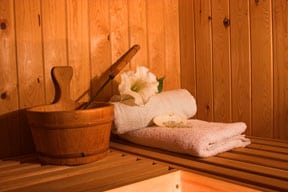
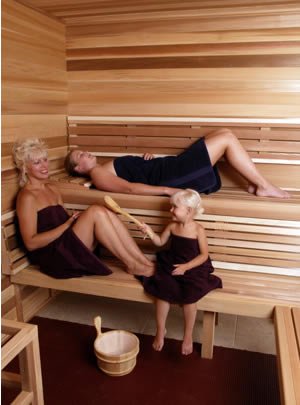
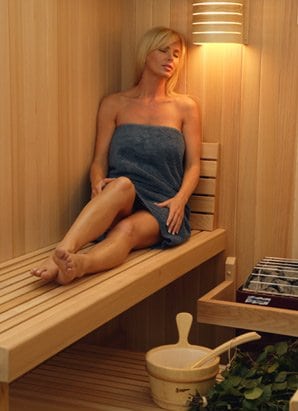
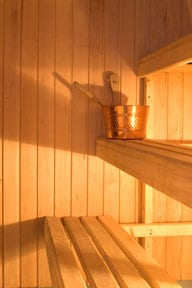
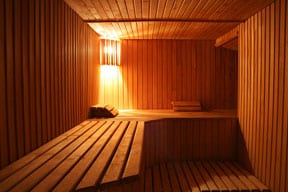

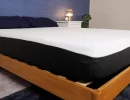



 Don Vandervort writes or edits every article at HomeTips. Don has:
Don Vandervort writes or edits every article at HomeTips. Don has: